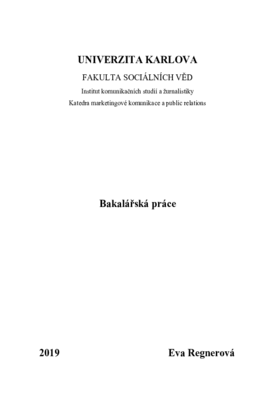Decoy effect a jeho využití v marketingu
Decoy effect and its use in marketing
bakalářská práce (OBHÁJENO)

Zobrazit/
Trvalý odkaz
http://hdl.handle.net/20.500.11956/110395Identifikátory
SIS: 204425
Kolekce
- Kvalifikační práce [19618]
Autor
Vedoucí práce
Oponent práce
Rosenfeldová, Jana
Fakulta / součást
Fakulta sociálních věd
Obor
Marketingová komunikace a public relations
Katedra / ústav / klinika
Katedra marketingové komunikace a public relations
Datum obhajoby
19. 9. 2019
Nakladatel
Univerzita Karlova, Fakulta sociálních vědJazyk
Čeština
Známka
Výborně
Klíčová slova (česky)
Decoy efekt, efekt asymetrické dominance, behaviorální ekonomie, efekt návnady v marketingu, experiment, replikaceKlíčová slova (anglicky)
Decoy effect, asymmetrically dominated effect, behavioral economics, decoy effect in marketing, experiment, replicationTato bakalářská práce se zabývá decoy efektem (česky efektem návnady), fenoménem behaviorální ekonomie. Především se soustředí na efekt asymetrické dominance. Hlavním cílem práce je zmapovat současný výzkum v oblasti decoy efektu a možnosti jeho využití v marketingové praxi. Práce je rozdělena na teoretickou a empirickou část. V první kapitole teoretické části práce je obecně vysvětlen princip fungování decoy efektu a popsány jeho možné modifikace. Další kapitola je věnována charakteristice efektu asymetrické dominance, základnímu typu efektu návnady. Jsou popsány jeho možná vysvětlení a limity. Práce také pojednává o oblastech testování efektu. Zvláštní pozornost je věnována využití efektu asymetrické dominance v marketingové komunikaci. Empirická část je pak tvořena replikací experimentu zabývajícího se obecnou platností efektu asymetrické dominance. V této části je krátce pojednáno o významu replikací. Závěry původního experimentu se replikovat nepodařilo, výsledky experimentu ovšem ukázaly efekt asymetrické dominance v některých výzkumných skupinách jako signifikantní.
This bachelor thesis examines decoy effect, a phenomenon of behavioral economics. Above all, it focuses on the asymmetrically dominated effect. The main objective of the thesis is to review recent research dealing with the decoy effect and analyze the possibilities of its use in marketing practise. The thesis consists of theoretical and empirical part. In the first chapter of the theoretical part the principle of the decoy effect is generally explained and its possible modifications are described. The second chapter characterizes the asymmetrically dominated effect, the primary type of the decoy effect. There are discussed possible explanations and limits of the effect. In the chapter there is also described wide scope of experiments testing the effect. Special attention is drawn to the use of the asymmetrically dominated effect in marketing communication. The empirical part is then formed by replication of an experiment focused on the general validity of the asymmetrically dominated effect. In this section the importance of replication of experiments is briefly explained. The results of the original experiment were not replicated. But the results of the experiment showed the asymmetrically dominated effect significant in some research groups.
